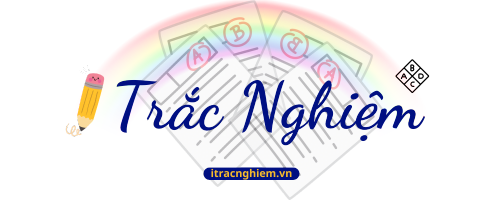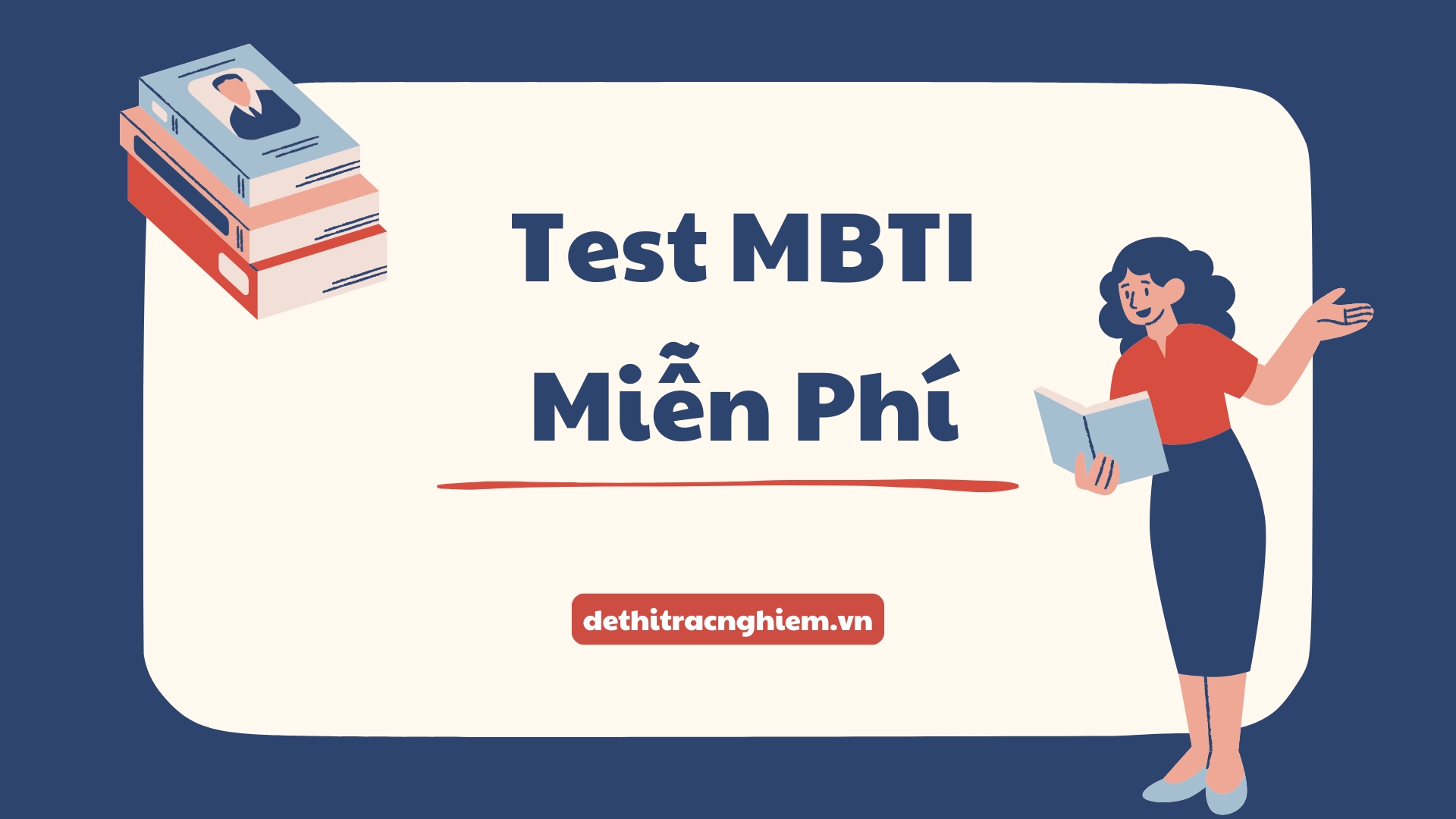Đề thi thử Đại học 2025 môn Tiếng Anh – Trường THPT Sơn Thịnh – Yên Bái là một trong những đề tiêu biểu thuộc Tổng hợp đề thi thử môn Tiếng Anh THPT QG, nằm trong chương trình Đề thi vào Đại học. Đây là đề thi do Trường THPT Sơn Thịnh – tỉnh Yên Bái tổ chức, với mục tiêu giúp học sinh lớp 12 luyện tập và làm quen với định dạng đề chuẩn của kỳ thi Tốt nghiệp THPT Quốc gia năm 2025.
Đề thi được xây dựng bám sát cấu trúc đề minh họa mới nhất của Bộ Giáo dục và Đào tạo, bao gồm đầy đủ các phần: ngữ âm (phát âm – trọng âm), ngữ pháp – từ vựng, chức năng giao tiếp, tìm lỗi sai, viết lại câu, và đọc hiểu. Các câu hỏi được sắp xếp theo mức độ từ cơ bản đến nâng cao, giúp học sinh phát triển toàn diện kỹ năng làm bài, đồng thời rèn luyện khả năng phản xạ, tư duy logic và quản lý thời gian hiệu quả.
Hãy cùng Dethitracnghiem.vn khám phá đề thi thử của Trường THPT Sơn Thịnh – Yên Bái và luyện tập ngay hôm nay để sẵn sàng bước vào kỳ thi Tốt nghiệp THPT năm 2025 với kết quả như mong đợi!
- Số trang: 4 trang
- Hình thức: Trắc nghiệm
- Thời gian làm bài: 50 phút (không kể thời gian phát đề)
ĐỀ THI THỬ ĐẠI HỌC MÔN TIẾNG ANH NĂM 2025 TRƯỜNG THPT SƠN THỊNH – YÊN BÁI
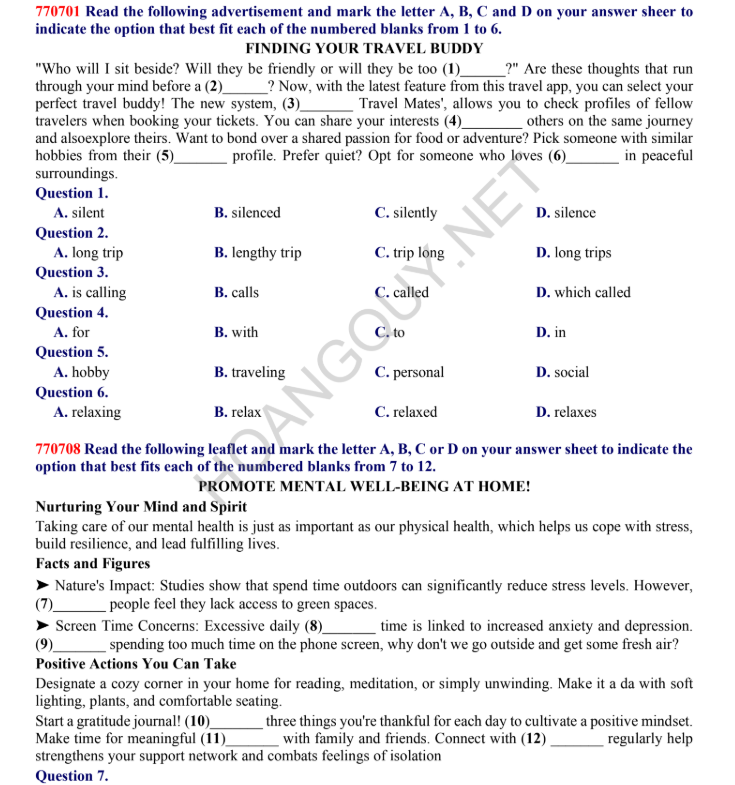
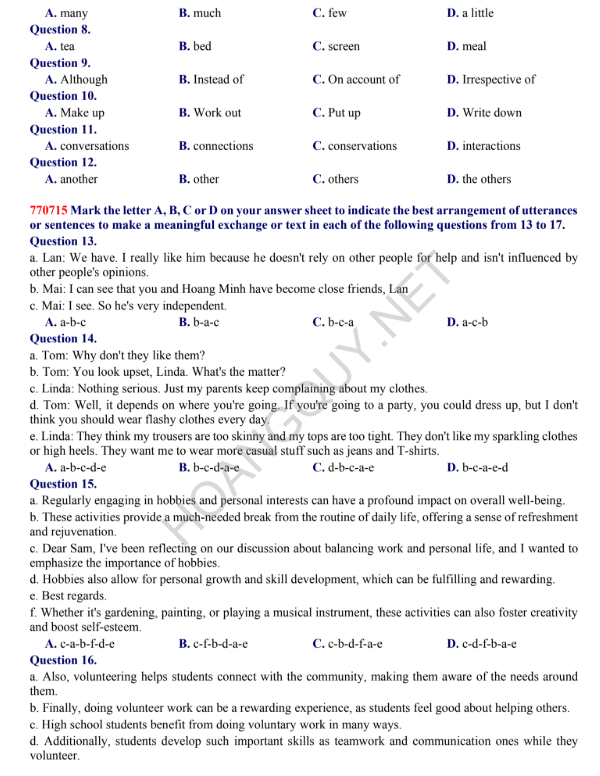

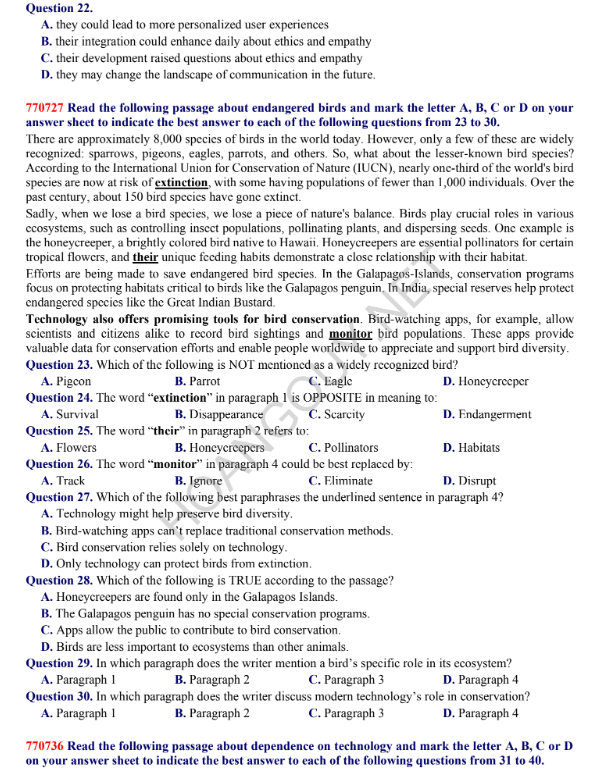
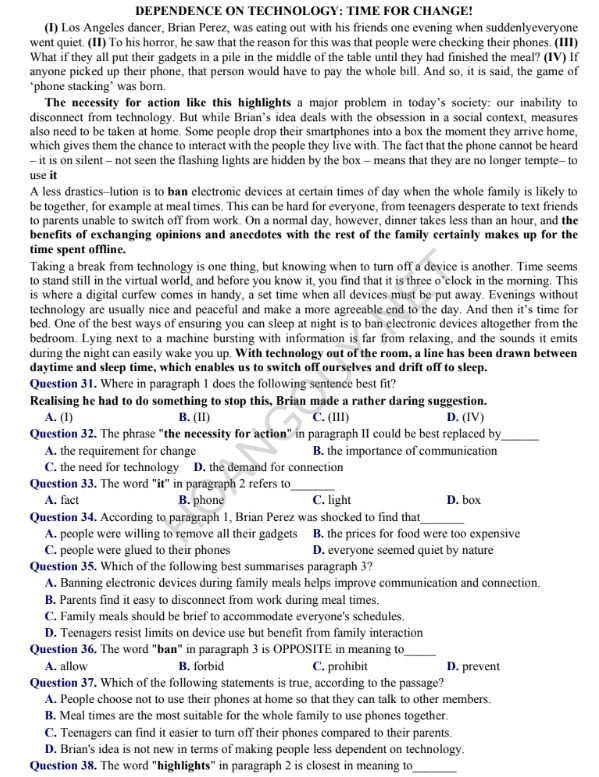
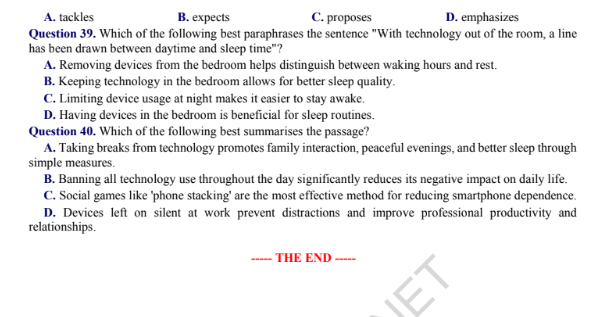
Read the following advertisement and mark the letter A, B, C or D on your answer sheet to indicate the correct word or phrase that best fits each of the numbered blanks from 1 to 6.
FINDING YOUR TRAVEL BUDDY
“Who will I sit beside? Will they be friendly or will they be too (1) _______?” These are thoughts that run through your mind before a (2) _______. Now, with the latest feature from this travel app, you can select your perfect travel buddy! The new system, (3) _______ ‘Travel Mates’, allows you to check profiles of fellow travelers when booking your tickets. You can share your interests (4) _______ others on the same journey and also explore theirs. Pick someone with similar hobbies from their (5) _______ profile. Prefer quiet? Opt for someone who loves (6) _______ in peaceful surroundings.
Question 1:
A. silent
B. silenced
C. silently
D. silence
Question 2:
A. long trip
B. lengthy trip
C. trip long
D. long trips
Question 3:
A. is calling
B. calls
C. called
D. which called
Question 4:
A. For
B. with
C. to
D. in
Question 5:
A. hobby
B. traveling
C. personal
D. social
Question 6:
A. relaxing
B. relax
C. relaxed
D. relaxes
Read the following leaflet and mark the letter A, B, C or D on your answer sheet to indicate the option that best fits each of the numbered blanks from 7 to 12.
PROMOTE MENTAL WELL-BEING-BEING AT HOME!
Nurturing Your Mind and Spirit
Taking care of our mental health is just as important as our physical health, which helps us cope with stress, build resilience, and lead fulfilling lives.
Facts and Figures
➤ Nature’s Impact: Studies show that spend time outdoors can significantly reduce stress levels. However, (7) _______ people feel they lack access to green spaces.
➤ Screen Time Concerns: Excessive daily (8) _______ time is linked to increased anxiety and depression. (9) _______ spending too much time on the phone screen, why don’t we go outside and get some fresh air?
Positive Actions You Can Take
Designate a cozy corner in your home for reading, meditation, or simply unwinding. Make it a da with soft lighting, plants, and comfortable seating.
Start a gratitude journal! (10) _______ three things you’re thankful for each day to cultivate a positive mindset. Make time for meaningful (11) _______ with family and friends. Connect with (12) _______ regularly help strengthens your support network and combats feelings of isolation
Question 7:
A. many
B. much
C. few
D. a little
Question 8:
A. Tea
B. bed
C. screen
D. meal
Question 9:
A. Although
B. Instead of
C. On account of
D. Irrespective of
Question 10:
A. Make up
B. Work out
C. Put up
D. Write down
Question 11:
A. conversations
B. connections
C. conversations
D. interactions
Question 12:
A. another
B. other
C. others
D. the others
Mark the letter A, B, C or D on your answer sheet to indicate the best arrangement of utterances or sentences to make a meaningful exchange or text in each of the following questions from 13 to 17.
Question 13:
a. Lan: We have. I really like him because he doesn’t rely on other people for help and isn’t influenced by other people’s opinions.
b. Mai: I can see that you and Hoang Minh have become close friends, Lan.
c. Mai: I see. So he’s very independent.
A. a-b-c
B. b-a-c
C. c-b-a
D. a-c-b
Question 14:
a. Tom: Why don’t they like them?
b. Tom: You look upset, Linda. What’s the matter?
c. Linda: Nothing serious. Just my parents keep complaining about my clothes.
d. Tom: Well, it depends on where you’re going to a party, you could dress up, but I don’t think you should wear flashy clothes every day.
e. Linda: They think my trousers are too skinny and my tops are too tight. They don’t like my sparkling clothes or high heels. They want me to wear more casual stuff such as jeans and T-shirts.
A. a-c-b-d-e
B. b-c-d-a-e
C. d-b-c-a-e
D. b-c-e-a-d
Question 15:
a. Regularly engaging in hobbies and personal interests can have a profound impact on overall well-being.
b. These activities provide a much-needed break from the routine of daily life, offering a sense of refreshment and rejuvenation.
c. Dear Sam, I’ve been reflecting on our discussion about balancing work and personal life, and I wanted to emphasize the importance of hobbies.
d. Hobbies also allow for personal growth and skill development, which can be fulfilling and rewarding.
e. Best regards.
f. Whether it’s gardening, painting, or playing a musical instrument, these activities can also foster creativity and boost self-esteem.
A. c-a-b-f-d-e
B. c-f-b-d-a-e
C. c-b-d-f-a-e
D. c-a-b-d-f-e
Question 16:
a. Also, volunteering helps students connect with the community, making them aware of the needs around them.
b. Finally, doing volunteer work can be a rewarding experience, as students feel good about helping others.
c. High school students benefit from doing voluntary work in many ways.
d. Additionally, students develop such important skills as teamwork and communication ones while they volunteer.
e. Firstly, students who do voluntary work gain valuable real-world experience which can help in their future careers.
A. c-a-e-b-d
B. e-a-c-b-d
C. c-e-a-d-b
D. c-e-d-a-b
Question 17:
a. It is reported that while Le and a few Qing officials were travelling, they came upon a Chinese poem written on a stone palette.
b. Le Quy Don, Director of the Bureau of Recorded Events and Rector of the National University, is admired for his broad knowledge and excellent memory.
c. After this event, the Chinese gave him a great deal of respect for it.
d. Later, a Qing official tested him by asking him to recall what was on the stone palette.
e. Le Quy Don read out loud in Mandarin the whole poem, word for word.
A. b-d-e-a-c
B. b-a-d-e-c
C. b-e-d-a-c
D. b-d-e-c-a
Read the following passage and mark the letter A, B, C or D on your answer sheet to indicate the correct word or phrase that best fits each of the numbered blanks from 18 to 22.
The development of humanoid robots has captured the imagination of many. One such creation is Apollo, a highly advanced robot designed for social interaction, (18) _______. Apollo made her first public appearance in 2020, showcasing her ability to converse and express emotions. Since then, she had participated in numerous tech conferences across the globe.
Apollo was developed by a team of engineers and psychologists (19) _______. This collaboration aimed to create a robot that could effectively understand and respond to human emotions, making her unique presence in the field of artificial intelligence. Apollo’s design is sleek and modern, (20) _______. His facial expressions and gestures are crafted to resemble those of a human, enhancing her ability to connect with people on a deeper level.
Equipped with advanced speech recognition technology, (21) _______. This allows him to engage in meaningful conversations and adapt his responses based on the emotional tone of discussion. As humanoid robots like Apollo become more integrated into society, (22) _______. They hold the potential to transform the way we interact with technology and each other.
Question 18:
A. that was created to bridge the gap between humans and machines
B. who aims to redefine human-robot relationships
C. which was designed to enhance social communication
D. that first stepped into the spotlight in the early 2020
Question 19:
A. whose goal was to merge technology with emotional intelligence
B. combining expertise in robotics and behavioral science
C. that collaborated to bring a human touch to robotics
D. whose members specialized in AI and human interaction
Question 20:
A. designed to be visually appealing while functional
B. inspired contemporary art and human anatomy
C. combining elements of both futuristic and classic designs
D. reflecting the aesthetics of modern robotics and human likeness
Question 21:
A. A variety of human languages can comprehend and respond to Apollo
B. Users uses sophisticated algorithms to interact with Apollo
C. Apollo understands context and nuance in human conversations
D. Apollo is programmed to facilitate discussions on various topics
Question 22:
A. They could lead to more personalized user experiences
B. Their integration could enhance daily ethics and empathy
C. Their development raised questions about ethics and empathy
D. They may change the landscape of communication in the future.
Read the following passage about endangered languages and mark the letter A, B, C or D on your answer sheet to indicate the best answer to each of the following questions from 23 to 30.
There are approximately 8,000 species of birds in the world today. However, only a few of these are widely recognized: sparrows, pigeons, eagles, parrots, and others. So, what about the lesser-known bird species? According to the International Union for Conservation of Nature (IUCN), nearly one-third of the world’s bird species are now at risk of (23) _______, with some having populations of fewer than 1,000 individuals. Over the past century, about 150 bird species have gone extinct.
Sadly, when we lose a bird species, we lose a piece of nature’s balance. Birds play crucial roles in various ecosystems, such as controlling insect populations, pollinating plants, and dispersing seeds. One example is the honeycreeper, a brightly colored bird native to Hawaii. Honeycreepers are essential pollinators for certain tropical (24) _______, and their unique feeding habits demonstrate a close relationship with their habitat.
Efforts are being made to save endangered bird species. In the Galapagos-Islands, conservation programs focus on protecting habitats critical to birds like the Galapagos penguin. In India, special reserves help protect endangered species like the Great Indian Bustard.
Technology also offers promising tools for bird conservation. Bird-watching apps, for example, allow scientists and citizens alike to record bird sightings and (25) _______ bird populations. These apps provide valuable data for conservation efforts and enable people worldwide to appreciate and support bird diversity.
Question 23:
A. Survival
B. Disappearance
C. Scarcity
D. Endangerment
Question 24:
A. Flowers
B. Honeycreepers
C. Pollinators
D. Habitats
Question 25: The word “monitor” in paragraph 4 could best be replaced by ______.
A. Track
B. Ignore
C. Eliminate
D. Disrupt
Question 26: Which of the following best paraphrases the underlined sentence in paragraph 4? “Technology also offers promising tools for bird conservation.”
A. Technology might help preserve bird diversity.
B. Bird-watching apps can’t replace traditional conservation methods.
C. Bird conservation relies solely on technology.
D. Only technology can protect birds from extinction.
Question 27: Which of the following is TRUE according to the passage?
A. Honeycreepers are found only in the Galapagos Islands.
B. The Galapagos penguin has no special conservation programs.
C. Apps allow the public to contribute to bird conservation.
D. Birds are less important to ecosystems than other animals.
Question 28: In which paragraph does the writer mention a bird’s specific role in its ecosystem?
A. Paragraph 1
B. Paragraph 2
C. Paragraph 3
D. Paragraph 4
Question 29: In which paragraph does the writer discuss modern technology’s role in conservation?
A. Paragraph 1
B. Paragraph 2
C. Paragraph 3
D. Paragraph 4
Question 30: The word “extinction” in paragraph 1 refers to _______.
A. Survival
B. Disappearance
C. Scarcity
D. Endangerment
Read the following passage about dependence on technology and mark the letter A, B, C or D on your answer sheet to indicate the correct answer to each of the questions from 31 to 40.
(I) Los Angeles dancer, Brian Perez, was eating out with his friends one evening when suddenly everyone went quiet. (II) To his horror, he saw that the reason for this was that people were checking their phones. (III) What if they all put their gadgets in a pile in the middle of the table until they had finished the meal? (IV) If anyone picked up their phone, that person would have to pay the whole bill. And so, it is said, the game of ‘phone stacking’ was born.
The necessity for action like this highlights a major problem in today’s society: our inability to disconnect from technology. Some people drop their smartphones into a box the moment they arrive home, which gives them the chance to interact with the people they live with. The fact that the phone cannot be heard, it is on silent – not seen the flashing lights are hidden by the box – means that they are no longer tempte– to use it.
A less drastic solution is to ban electronic devices at certain times of day when the whole family is likely to be together, for example at meal times. This can be hard for everyone, from teenagers to desperate to text friends to parents unable to switch off from work. On a normal day, however, dinner takes less than an hour, and the benefits of exchanging opinions and anecdotes with the rest of the family certainly makes up for the time spent offline.
Taking a break from technology is one thing, but knowing when to turn off a device is another. Time seems to stand still in the virtual world, and before you know it, you find that it is three o’clock in the morning. This is where a digital curfew comes in handy, a set time when all devices must be put away. Evenings without technology are usually nice and peaceful and make a more agreeable end to the day. And then it’s time for bed. One of the best ways of ensuring you can sleep at night is to ban electronic devices altogether from the bedroom. Lying next to a machine bursting with information is far from relaxing, and the sounds or emits during the night can easily wake you up. With technology out of the room, a line has been drawn between daytime and sleep time, which enables us to switch off ourselves and drift off to sleep.
Question 31: Where in paragraph 1 does the following sentence best fit? “Realising he had to do something to stop this, Brian made a rather daring suggestion.”
A. (I)
B. (II)
C. (III)
D. (IV)
Question 32: The phrase “the necessity for action” in paragraph II could best be replaced by _______.
A. the requirement for change
B. the importance of communication
C. the need for technology
D. the demand for connection
Question 33: The word “it” in paragraph 2 refers to _______.
A. fact
B. phone
C. light
D. box
Question 34: According to paragraph 1, Brian Perez was shocked to find that _______.
A. people were willing to remove all their gadgets
B. the prices for food were too expensive
C. people were glued to their phones
D. everyone seemed quiet by nature
Question 35: Which of the following best summarises paragraph 3?
A. Banning electronic devices during family meals helps improve communication and connection.
B. Parents find it easy to disconnect from work during meal times.
C. Family meals should be brief to accommodate everyone’s schedules.
D. Teenagers resist limits on device use but benefit from family interaction
Question 36: The word “ban” in paragraph 3 is OPPOSITE in meaning to _______.
A. allow
B. forbid
C. prohibit
D. prevent
Question 37: Which of the following statements is true according to the passage?
A. People choose not to use their phones at home so that they can talk to other members.
B. Meal times are the most suitable time for the whole family to use phones together.
C. Brian’s idea is not new in terms of making people less dependent on technology.
D. Devices left on silent at work prevent distractions and improve professional productivity and relationships.
Question 38: The word “highlights” in paragraph 2 is closest in meaning to _______.
A. tackles
B. expects
C. proposes
D. emphasizes
Question 39: Which of the following best paraphrases the sentence “With technology out of the room, a line has been drawn between daytime and sleep time”?
A. Removing devices from the bedroom helps distinguish between waking hours and rest.
B. Keeping technology in the bedroom allows for better sleep quality.
C. Limiting device usage at night makes it easier to stay awake.
D. Having devices in the bedroom is beneficial for sleep routines.
Question 40: What is the main idea of the passage?
A. Taking breaks from technology promotes family interaction, peaceful evenings, and better sleep through simple measures.
B. Banning all technology use throughout the day significantly reduces its negative impact on daily life.
C. Social games like ‘phone stacking’ are the most effective method for reducing smartphone dependence.
D. Devices left on silent at work prevent distractions and improve professional productivity and relationships.
Mục đích tổ chức kỳ thi Đại học năm 2025 là gì?
Căn cứ theo quy chế hiện hành của Bộ Giáo dục và Đào tạo và các văn bản hướng dẫn tổ chức kỳ thi Đại học năm 2025, mục đích của kỳ thi là:
– Đánh giá kết quả học tập của học sinh sau 12 năm học theo yêu cầu của chương trình giáo dục phổ thông.
– Lấy kết quả thi để xét công nhận tốt nghiệp trung học phổ thông và làm căn cứ tuyển sinh đại học, cao đẳng.
– Góp phần đánh giá chất lượng giáo dục của địa phương và cả nước, làm cơ sở điều chỉnh nội dung, phương pháp dạy học trong nhà trường.
Thí sinh thi Đại học năm 2025 có bắt buộc thi môn Tiếng Anh không?
Theo quy định hiện hành của Bộ Giáo dục và Đào tạo và hướng dẫn tổ chức kỳ thi tốt nghiệp Đại học năm 2025, thí sinh dự thi phải thực hiện như sau:
– Thi 3 môn bắt buộc: Toán, Ngữ văn và Ngoại ngữ.
– Ngoài ra, thí sinh phải chọn một trong hai bài thi tổ hợp: Khoa học Tự nhiên (gồm các môn Vật lí, Hóa học, Sinh học) hoặc Khoa học Xã hội (gồm các môn Lịch sử, Địa lí, Giáo dục công dân – dành cho học sinh học chương trình giáo dục phổ thông).
Trong số các môn thi, Tiếng Anh là một trong ba môn thuộc bài thi Ngoại ngữ bắt buộc, thí sinh phải thi môn Tiếng Anh như một môn bắt buộc, không phụ thuộc vào lựa chọn bài thi tổ hợp hay mục đích xét tuyển đại học.
Như vậy, kỳ thi Đại học năm 2025 bắt buộc thí sinh phải thi môn Tiếng Anh.
